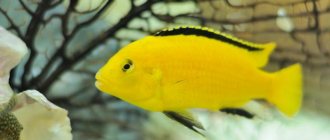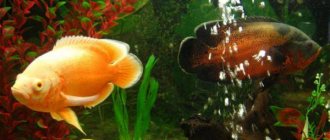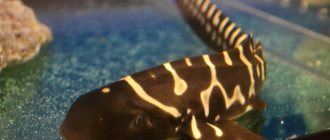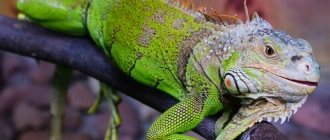If you decide to buy an aquarium, then the first fish you should buy is a catfish. They are very good orderlies who clean the bottom of mucus. There are a large number of species of aquarium catfish, the size of which can range from a few centimeters to a couple of meters. The structure of their body is quite unusual, which makes catfish a favorite of many aquarists. In order to introduce catfish into your aquarium, you must know what kind of care they require, the peculiarities of their maintenance and compatibility with other fish.
Aquarium fish catfish
There are 2,000 varieties of aquarium catfish. The sizes of the fish are different - there are individuals from 3 to 35 cm. Aquarium catfish lead a bottom lifestyle, preferring nocturnal activity. Near the mouth there is a characteristic tuft of sensitive antennae that allow catfish to navigate in space.
Most of the different species, but only peaceful ones, get along well with each other and various peaceful fish in the same aquarium.
Table of basic parameters of maintenance, care and nutrition:
| What should be the volume of an aquarium for catfish? | from 30 liters for 1 individual up to 10 cm in size |
| What should be the temperature in an aquarium for catfish? | from +18-30° C |
| What pH should be in the aquarium? | from 5.5-8 pH |
| What should be the hardness of the water in the aquarium? | from 5-25° dH |
| What should be the substrate for an aquarium? | any without sharp corners |
| What kind of lighting should be in the aquarium? | moderate |
| What should be the movement of water in the aquarium? | moderate, but some species require intense water movement |
| Maximum size of soms | from 2-35 cm (depending on the type) |
| What does aquarium catfish eat? | dry food; live food |
| Type of aquarium catfish | peaceful, but there are predatory species |
| Who is compatible with in an aquarium? | get along with all non-aggressive fish species |
| Lifespan | 6-10 years in an aquarium (depending on the species) |
Description
The cockroach came to aquariums from the central and northern regions of South America, where it is found in the Amazon and Orinoco river basins. Its natural habitats are also the fresh waters of the coastal rivers of northern Brazil and Havana.
The tarakatum catfish, like most of its decorative relatives, belongs to the family of armored catfish. The maximum length of its body is 18 cm, but the size of the fish depends on the volume of the aquarium, and in captivity these catfish do not grow more than 12 cm. The color of the cockroach varies in the brown range, the scales of some individuals may have a dark purple tint. The fry are almost black in color and lighten as they grow older. Adults may turn beige. The body of the fish is covered with spots of regular shape, which become more and more noticeable over time. Both sexes have 2 pairs of whiskers: one of them is directed forward and down, and the second is directed up and to the sides. The abdomen is light and has a beige tint.
Catfish maintenance and care
Catfish are one of the few representatives of aquarium inhabitants that do not require special conditions of detention. But for a comfortable life, the size of the aquarium should be from 30 liters per 1 individual for a catfish up to 10 cm in size. Also, the aquarium must have caves or something like that; catfish like to hide during the day and swim around the aquarium at nightfall. It is not necessary, but the presence of any aquarium plants is recommended, for example: various types of Sagittaria, any type of Vallisneria, Limnophila and many others.
Any soil is suitable, but preferably without sharp corners. The water temperature must be set for a specific type, which ranges from +18-30° C, acidity from 5.5-8 pH and hardness from 5-25° dH.
Catfish tolerate small changes in temperature, acidity and hardness quite well, however, a long-term imbalance will lead to illness and death.
The aquarium must have aeration and filtration. Change water by 30% weekly.
Compatibility
Most representatives of catfish, due to their friendly and peaceful nature, get along well with their relatives and other aquarium fish. Modest and quiet, catfish do not enter into conflicts or start fights, but with the wrong neighbors they can become victims. Introducing predatory fish, for example, astronotus, into the same aquarium together with catfish can lead to the death of the latter. It is also not recommended to place small and weak fish - guppies, neons and others - in a tank with predatory catfish, since pets may consider them food.
Interesting fact: the European catfish can weigh up to 400 kg, and is even capable of attacking people.
What does catfish eat in an aquarium?
Properly organized nutrition is the key to successful growth and development of fish. If you overfeed, there is a high probability of death of the aquarium inhabitants.
Most catfish are omnivores and have no special dietary preferences. Small, peaceful species of catfish most often feed on plaque on the walls, decorations and aquarium plants in the aquarium. If there are other inhabitants in the aquarium, for example: Guppies, Neon, Norman's blue-eye, Mollies, Swordtails, Danios, and the food that these inhabitants were fed settles at the bottom of the aquarium, then the catfish eats it. Therefore, it is best to feed once late in the evening and very little. Or for better health, feed only 2 times on certain days during the week in small doses.
If there are no other inhabitants or there are few of them, so there is not enough food, then the optimal mixtures are dry food with a balanced composition. You can also use bloodworms, daphnia and cyclops - live food.
Some members of the family require periodic intake of meat with a reduced content of animal fats and spirulina tablets.
Nutrition
Feeding catfish is even simpler than keeping them. If your pets live in a tank with other fish, then you don’t have to feed the catfish at all - they will happily pick up leftover food from their neighbors, at the same time cleaning the area. When keeping only catfish fish, you can offer your wards the following products:
- Live and frozen food: bloodworms, tubifex, cyclops, shrimp, etc.
- Catfish tablets and flakes.
- Plant foods: cucumber, spinach, green peas, broccoli, etc.
Before serving, live food must be thoroughly washed, and plant food must be scalded with boiling water. If a predatory catfish lives in the tank, you should remember that small neighbors can become its lunch.
Interesting fact: hungry and predatory catfish living in their natural environment can drag even a dog to the bottom.
Catfish: how to distinguish a male from a female
To successfully breed aquarium catfish, it is necessary to distinguish females from males. There are a number of criteria that allow you to correctly perform this task, but each species has its own differences between male and female:
- body dimensions. Female representatives are much larger than males;
- growths on the face. The male, as a rule, has growths (antennae), but the female does not;
- the abdominal line has a course directed towards the bottom;
- The color of males is always much brighter than that of females;
- Owners should also pay attention to the area of the abdominal line located near the anus. Females have a characteristic depressed pit, while males have a small tubercle.
Of course, in this case the list of criteria is incomplete. A number of sexual differences are strictly specific for each type of aquarium catfish. It is better to clarify these features with specialists - ichthyologists or sales consultants when purchasing catfish.
Types of catfish
Speckled Corridor
The average length of a male is from four to six centimeters, a female is up to seven centimeters. They are olive-brown in color with many dark spots. Their belly is yellow. The sides of the body have 2 lines of bony plates, and harsh spines are located on the dorsal and pectoral fins. The front of the head is decorated with a pair of antennae.
Ancistrus
Length - up to fourteen centimeters. The color varies, starting from light gray with a yellow tint and ending with dark gray with light spots. The crown of the slightly flattened body is the voluminous head. The first rays of the fins are much thicker than the others and are equipped with spines; there are lines of bony plates on the body. There are spines hidden at the base of the head. The male is emphasized by his full “horns,” elastic skin growths on his nose. Females are a little more massive, their growths are almost smooth.
Tarakatum
The average length is from sixteen to seventeen centimeters. The male is smaller than the female. Color: coral. There are large black spots that darken over the years. The belly of females is light, that of males is coral, and during breeding it is blue. The body is oblong, with a high dorsal crest, a flat belly and a thickened base of the tail. The lower part of the wide head is flat. There are 3 pairs of short antennae.
Pterygoplicht brocade
Length - up to twenty centimeters. The coloring echoes the leopard pattern: brown-black spots bordered with yellow are located on the body. Over the years, the picture becomes smaller and may disappear completely. The body is flattened and long. The scales are made up of bone plates. With a high dorsal fin, full pectoral and ventral fins.
Synodontis
The average length is from six to nine and a half centimeters.
The female is larger than the male. Gray-beige color with black-brown spots, belly slightly darker. With a stocky, slightly flattened body at the sides. The caudal fin has 2 blades and a triangular dorsal fin. Synodontis has large eyes and 6 antennae in the mouth area. We also recommend reading:
Pet: why does the dog refuse to go for walks When and why do kittens change eye color? Why a cat won't accept kittens, and how to deal with it Unusual facts about the cat's nose
White-spotted agamixis
Length - up to twelve centimeters. The female is more massive and duller. With brown-black color. Has pale yellow spots. The body is large and long. There are bone plates and spines. The head is large, flattened, with 3 pairs of speckled mustaches. The dorsal fin is triangular in shape. It has a tooth on the front ray, small and rounded ventral fins. The female has a remarkably large, unshaped belly.
Callicht
Size - up to fifteen centimeters. Coloring ranges from olive green to dark gray with large dark spots. In males, the anterior ray in the pectoral fin is notable for its orange color. The body is long, slightly flattened on the sides, on which there are 2 lines of bone plates; not the entire back is covered with them. The flattened upper part is voluminous with 3 pairs of antennae in the mouth area of the head.
Brohis
The average size is from eight to nine centimeters. The female is larger and has a more rounded belly. Brochis has a greenish color with a cast of sides, a brownish back and a bright yellow belly. These fish have a large head and a long body, which elastically smoothly descends towards the tail cover. On the flat sides there are 2 lines of strong plates and a two-lobed tail cover.
Catfish anchor
Length - up to three and a half centimeters. The female is longer and more massive. Coloring ranges from reddish-brown to dark brown with dark spots and stripes. The upper part of the body is curved, the size of the pectoral fins is proportionally long, and there are tubercles on the skin.
Interesting fact. The river catfish is distinguished by its extraordinary cunning. He hunts without moving. To lure prey, the catfish copies the worms with elastic movements of its antennae. At the moment when the victim is at a close distance from the catfish, it quickly sucks in water along with the victim.
Reproduction of catfish in an aquarium
To stimulate reproduction, depending on the species, you need to lower or increase the temperature of the water in the aquarium, but do not forget about the other inhabitants of the aquarium. Therefore, it is better to place the female and male in a separate aquarium (spawning tank), where the necessary conditions can be created to stimulate reproduction without harm to other inhabitants of the aquarium. The size of the spawning tank should be from 30 liters, it should have caves, aquarium plants, and snags. You also need a balanced diet.
Spawning in almost all species of catfish lasts up to 5 days. The male, having chosen a place in the aquarium, cleans it, after which the female lays eggs, which the male immediately fertilizes. The female usually goes back to the general aquarium, and the male goes after the eggs.
How does the mating process occur?
For reproduction, a sexually mature pair of fish is needed, however, according to the recommendations of many breeders, there should be several females per male. The incentive to start spawning is a protein diet. During this period, the fish must be given live or frozen bloodworms, brine shrimp, daphnia, and tubifex.
Important! Catfish can eat their own eggs; therefore, 2 separate aquariums should be provided for spawning and raising offspring.
Types of aquarium catfish with photos, names and descriptions
The family of aquarium catfish is characterized by a wide variety of species, differing in their appearance, living conditions, care and nutrition requirements.
Catfish Ancistrus vulgaris or Ancistrus Claro - description, content, what to feed and reproduction
Ancistrus catfish are representatives of the most popular species of catfish and there are 30 varieties. One of the most popular is Ancistrus vulgaris or Ancistrus Claro; aquarists also call them: sticky catfish, cleaner catfish, sucker.
In an aquarium they grow up to 10 cm, but can reach up to 15 cm - this depends on the size of the aquarium and nutrition. A characteristic feature is the presence of a kind of suction cup located around the mouth.
Representatives of the species are also distinguished by many growths on the face and a specific dark coloring of the skin. They are not at all aggressive towards other types of ornamental fish, but can stick with their suction cups to species of aquarium fish that are too slow.
Ancistrus vulgaris prefers a warmer living temperature of +20-26° C. The recommended acidity of the aquatic environment is from 6-7.5 pH. Hardness up to 20° dH. Aquarium size for a couple of individuals from 50 liters. With proper maintenance, the lifespan is up to 6-8 years; it happens that they live up to 12 years.
In terms of nutrition, the common ancistrus has no special rules: dry and live food. The best tablets are those that sink to the bottom with plant or animal ingredients.
There is no need to create special conditions for the propagation of Ancistrus Claro. The male cleans the place in the aquarium that he has chosen as a spawning site. The female throws from 30–100 eggs with a diameter of 2–3 mm, bright orange and yellow eggs, which the male inseminates.
After the female lays eggs, it is better to deposit them, the male will take care of the eggs himself. He will remove dead eggs and fan the eggs with his fins to supply oxygen. If there are several females and one male in the aquarium, then the male will look after all the clutches in the aquarium.
If there are no males in the aquarium, but only a female, she can reproduce on her own - lay eggs and inseminate them, changing sex.
If necessary, a pair of catfish is placed in a container with a volume of 40 liters or more, and the owners will need to slightly stimulate reproduction by changing the living conditions.
Among Ancistrus there are also popular types: Ancistrus Veiled, Red, Diamond, Star-shaped, Black.
Catfish Ancistrus albino or golden - description, content, what to feed, reproduction
Representatives of this species have gained particular popularity among aquarium owners due to their specific appearance. Under optimal conditions, their length can range from 6 to 17 cm. The body of the albino catfish is long, flattened, and has a wide head. An important feature is the voluminous lips, which allow the catfish to remove food from hard surfaces. On the surface of the entire body and head there is a huge number of skin growths - a kind of sexual characteristic. Body color ranges from white to golden hue.
Like most representatives of its family, this species leads a bottom-dwelling lifestyle, preferring the dark time of day for activity. For optimal growth and reproduction, it is necessary to use at least 60 liters for a pair of individuals. The maximum temperature threshold ranges from +20-24° C. Acidity from 6.5-7.5 pH. Any hardness is suitable, since there is no sensitivity to it. To decorate an aquarium, experts recommend using plants with dense stems, since catfish clean the bottom and walls, breaking down fragile algae. Life expectancy is up to 5 years.
Ancistrus albino catfish are unpretentious in their diet; they readily eat dry, live and plant food. The main rule for the owner is to ensure that the food sinks to the bottom. Uneaten remains must be removed from the pond immediately to avoid overfeeding.
Under comfortable conditions, Ancistrus aureus themselves will begin to reproduce quite quickly. Placing sexually mature individuals in separate aquariums, additional stimulation of spawning is not required - it is enough to ensure optimal care of the aquatic environment.
Catfish Agamix star - description, content, what to feed, reproduction
The Agamix star catfish has a powerful body, reaching a length of up to 17 cm in the wild, and up to 10-12 cm in an aquarium. The head is flattened with three pairs of antennae on the lateral surfaces. The body tends to narrow as it moves towards the tail. The very tip of the tail is covered with bony plates, which give the catfish a ribbed appearance. Color of the body and fins: brown background with bright yellow spots.
The volume of the aquarium for representatives of this species of 4 individuals must be at least 100 liters; with smaller values, the growth of catfish slows down. Acidity from 6-7.5 pH, water hardness up to 25° dH and temperature from +25-30° C. Fish are very mobile, so it is better to decorate the aquarium with algae, underwater caves, and large, non-sharp pebbles. Lifespan in an aquarium is up to 10 years.
Feeding is carried out mainly in the evening, since this period is the peak of fish activity. They prefer live food with the addition of 1/5 of the plant diet. Catfish pick up all their food from the surface of the bottom, so large pebbles are the best base for an aquarium.
Breeding of star catfish begins after 2 years of age - it is during this period that individuals reach sexual maturity. Principles of stimulation for spawning:
- abundant feeding. The frequency of feeding is increased to 3 times a day;
- frequent replacement of water in the aquarium;
- reducing the hardness of the aquatic environment.
Sometimes additional drug stimulation is used in the form of injections of gonadotropin hormone into the fins. The ratio of males to females required for successful reproduction is 1:1.
Catfish Corydoras - description, maintenance, what to feed, reproduction
In zoological stores you can find a wide variety of Corydoras catfish. Each representative has a unique coloration, characteristic of individual 150 species. Here are some of them:
The body is represented by a narrow long layer with a convex back, covered with a shiny shell. The mouth is characterized by a low position, which facilitates eating food from the bottom. Three pairs of antennae located along the mouth opening help fish navigate in space and search for food.
Corydoras catfish, depending on the species, grow from 2-10 cm. The content in the aquarium also depends on the species, temperature range from + 18-30 ° C, acidity from 5.5-8 pH, hardness from 5-18 ° dH. For 8 individuals you need an aquarium of 60 liters. Life span is up to 6-10 years depending on the species. The soil at the bottom should not contain sharp edges or stones so that the catfish do not damage their antennae. Good water filtration and sufficient oxygen content are the key to successful growth and reproduction of aquarium fish of this species. Too high a temperature and cloudy water can slow down the growth of aquarium inhabitants.
Simik's diet should be varied, including dry food and special tablets with a high content of shrimp. Shrimp are a source of unsaturated fatty acids, which provide catfish with optimal growth, protection from diseases, and timely reproduction.
For breeding, you will need to select several large males and one female, and prepare an aquarium with a volume of more than 35 liters. Important components for successful spawning: lowering water temperature, increasing oxygen levels in the aquatic environment.
Catfish Hypancistrus Zebra or Zebra Pleco - description, content, what to feed, reproduction
Catfish Hypancistrus Zebra or Zebra Pleco are small fish up to 7-10 cm long, the color of which has the appearance of original black and white stripes. A distinctive feature is their wide fins, which allow catfish to move quickly. Maintenance conditions: temperature from +26-30° C, acidity from 6 -7.5 pH, hardness up to 12° dH, high oxygen content and constant water filtration.
The most rational diet is a balance of natural and artificial food, which includes algae, plankton, and mixed feed. If these parameters are not observed, the fish quickly lose their external decor, become unstable to diseases, and become prone to allergic reactions.
It is quite simple to distinguish a male from a female catfish Hypancistrus Zebra. The male has a wider head and a thicker ray of the first pectoral fin, which is covered with hairs during spawning.
Reproduction occurs in the spring-autumn season. For spawning, a fish tank with a sufficient capacity of 35 liters is prepared. The main principles are spawning temperature +28-30° C and a balanced diet. Also the presence of a large number of shelters with minimal lighting.
How to care for caviar
After spawning is completed, the couple should be moved to another container. Temperature affects how the eggs will mature - the warmer the water, the sooner the fry will hatch. On average, it takes eight to twelve days for the eggs to mature.
For the fruitful development of the fry, you should maintain the temperature from +19 to +21 ° C, change part of the water from time to time, leave only natural lighting or slightly shade the aquarium from light.
Important! There may be slight differences in the conditions for breeding catfish, depending on the species; therefore, before purchasing them, you need to familiarize yourself with the characteristics of this species and consult with specialists.
Diseases of aquarium catfish: signs and treatment
Despite the minimum care requirements, aquarium catfish are also susceptible to various diseases. Among the main causes of catfish death, the following should be noted:
Semolina for catfish
Ichthyophthyridiasis/semolina develops when individuals are infected with parasites. A scattering of small white spots appears on the body. These points are a kind of pockets in which the parasite itself is located.
Treatment consists of treating the aquatic environment with solutions of potassium permanganate, copper sulfate, and formaldehyde until the white spots completely disappear.
Oodiniosis in catfish
An infected fish may show only minor symptoms for several years: scratching on stones, flinching, pale skin. When the process is developed, the armor or skin layer begins to peel off from the body of the catfish, exposing accumulations of parasites.
The drug for treatment is Bicillin-5. Penicillins have a bactericidal effect, completely removing parasites from the body surface of aquarium catfish.
Diseases from stress in catfish
There is also a pathological formation of white spots, which should be distinguished from the manifestation of stress in the inhabitants of the aquarium. In addition to infectious and parasitic diseases, there are a number of pathological conditions that develop as a result of defects in care:
- Digestive disorders due to poor nutrition. It manifests itself as stool disorder in fish, decreased activity, and loss of appetite. Treatment consists of optimizing the diet.
- Oxygen starvation when there is a lack of oxygen in the water. The first symptoms are the frequent floating of fish to the surface of the water surface.
- Non-optimal temperature conditions. The fish lose their mobility, the skin becomes pale, and their appetite decreases.
In all three cases, symptoms can be supplemented by the appearance of large white spots, as a manifestation of stress. Treatment consists of optimizing the regimen and conditions of care.
Ancitrus catfish - types, maintenance and reproduction, video:
Diseases
Ancistrus catfish are not in poor health, but some diseases also affect them. A common cause of disease is failure to maintain cleanliness and hygiene of the aquarium, untimely change of water, and rotting of food particles stuck between stones. Therefore, the best prevention of diseases in the aquarium inhabitants is timely cleaning and replacement of water.
In order to promptly determine the deteriorating health of ancistrus, you need to monitor the condition of your pets every day. If you recognize the disease in advance, it can be easily cured.
Symptoms of a sick catfish:
- Unusual behavior, uncharacteristic actions. Sluggish and inhibited or overly active behavior in combination with other symptoms indicates some kind of disturbance in the body.
- Change in fish color. More often the yellow color fades and loses its brightness. But this also happens after the spawning process, so this symptom is inaccurate.
- Poor appetite or its complete absence. Healthy fish are always ready to feed and swim to the place of food. And the patient remains in the shelter and does not touch the food.
- The formation of unhealthy plaque on the skin and scales.
Fish with one or more symptoms are separated from the others. Most often, catfish are affected by fin rot, swim bladder disorder and bacterial diseases.
Caring for fry
As soon as the fry have appeared, they are first fed with the yolk sac of the eggs. Then their further food turns out to be ciliates and special dry food for fry or regular food, but crushed into powder form.
After one to one and a half weeks, larger amounts of live food can be included in the diet.
Now you have learned that breeding catfish is not that difficult. This is also feasible for amateur aquarists. Provide your fish with good conditions for fertilization, a complete diet, and nature will take care of the rest.











